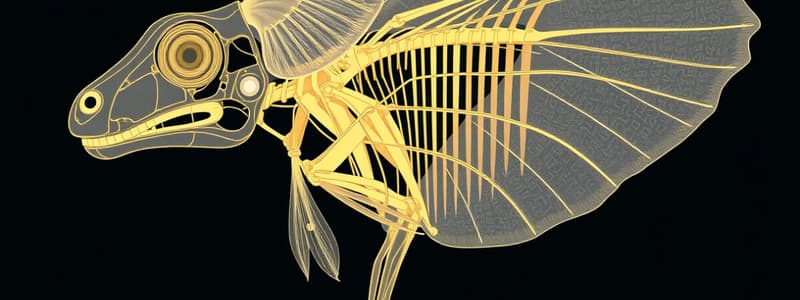Podcast
Questions and Answers
What is the main reason for classification of animals?
What is the main reason for classification of animals?
To assign a systematic position to newly described species and understand their relationships.
Which level of organization is exhibited by sponges?
Which level of organization is exhibited by sponges?
- Tissue level
- Organ level
- Organ system level
- Cellular level (correct)
Which group of animals exhibits the organ system level of organization?
Which group of animals exhibits the organ system level of organization?
- Sponges
- Coelenterates
- Annelids (correct)
- All of the above
All members of Animalia have the same pattern of cell organization.
All members of Animalia have the same pattern of cell organization.
What defines a complete digestive system?
What defines a complete digestive system?
How are animals categorized based on symmetry?
How are animals categorized based on symmetry?
What is the importance of classification in the animal kingdom?
What is the importance of classification in the animal kingdom?
Which level of organization exhibits the most complex arrangement of cells?
Which level of organization exhibits the most complex arrangement of cells?
All members of Animalia exhibit the same pattern of organization of cells.
All members of Animalia exhibit the same pattern of organization of cells.
The digestive system in Platyhelminthes is called _______.
The digestive system in Platyhelminthes is called _______.
What type of symmetry do sponges exhibit?
What type of symmetry do sponges exhibit?
Which type of circulatory system involves directly bathing cells and tissues in blood?
Which type of circulatory system involves directly bathing cells and tissues in blood?
Flashcards are hidden until you start studying
Study Notes
Basis of Classification
- Animal classification is essential due to the over a million described species.
- It helps assign a systematic position to newly identified species.
- Common fundamental features for classification include arrangement of cells, body symmetry, coelom nature, and system patterns (digestive, circulatory, reproductive).
Levels of Organisation
- All members of Animalia are multicellular but display different cell organization:
- Cellular Level: Seen in sponges with loose cell aggregates and some division of labor among cells.
- Tissue Level: Observed in coelenterates where similar-function cells form tissues.
- Organ Level: Found in Platyhelminthes, where tissues group into specialized organs.
- Organ System Level: Present in Annelids, Arthropods, Molluscs, Echinoderms, and Chordates, where organs form functional systems for various physiological functions.
Digestive System Variations
- Incomplete Digestive System: Platyhelminthes have a single opening functioning as both mouth and anus.
- Complete Digestive System: Characterized by having both a mouth and anus.
Circulatory System Types
- Open Circulatory System: Blood is pumped out of the heart, bathing cells and tissues directly.
- Closed Circulatory System: Blood circulates through vessels (arteries, veins, capillaries).
Symmetry in Animals
- Asymmetrical Animals: Sponges do not divide evenly along any central plane.
- Further classification of animals can be established based on their symmetry types.
Basis of Classification
- Animal classification is essential due to the over a million described species.
- It helps assign a systematic position to newly identified species.
- Common fundamental features for classification include arrangement of cells, body symmetry, coelom nature, and system patterns (digestive, circulatory, reproductive).
Levels of Organisation
- All members of Animalia are multicellular but display different cell organization:
- Cellular Level: Seen in sponges with loose cell aggregates and some division of labor among cells.
- Tissue Level: Observed in coelenterates where similar-function cells form tissues.
- Organ Level: Found in Platyhelminthes, where tissues group into specialized organs.
- Organ System Level: Present in Annelids, Arthropods, Molluscs, Echinoderms, and Chordates, where organs form functional systems for various physiological functions.
Digestive System Variations
- Incomplete Digestive System: Platyhelminthes have a single opening functioning as both mouth and anus.
- Complete Digestive System: Characterized by having both a mouth and anus.
Circulatory System Types
- Open Circulatory System: Blood is pumped out of the heart, bathing cells and tissues directly.
- Closed Circulatory System: Blood circulates through vessels (arteries, veins, capillaries).
Symmetry in Animals
- Asymmetrical Animals: Sponges do not divide evenly along any central plane.
- Further classification of animals can be established based on their symmetry types.
Studying That Suits You
Use AI to generate personalized quizzes and flashcards to suit your learning preferences.




